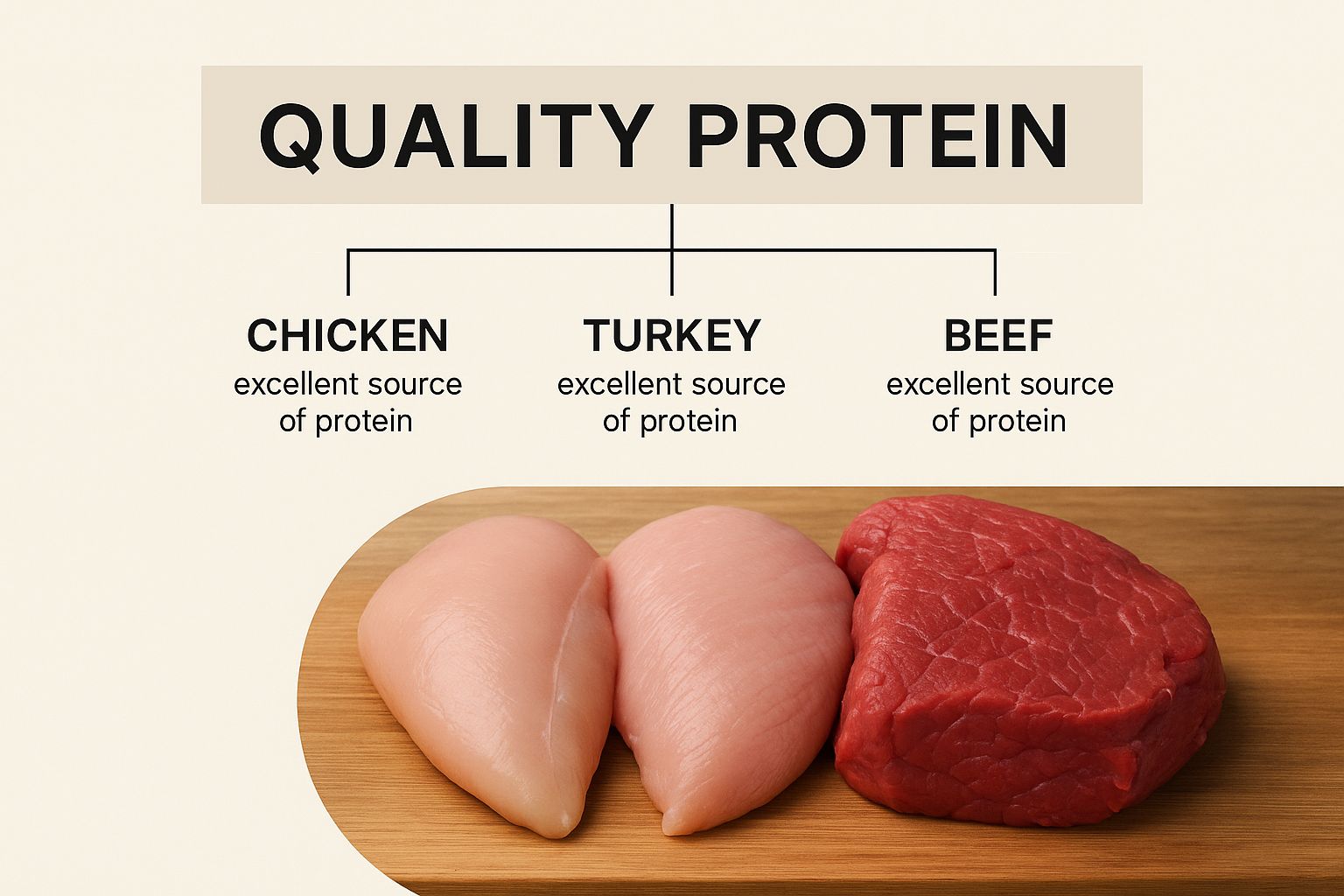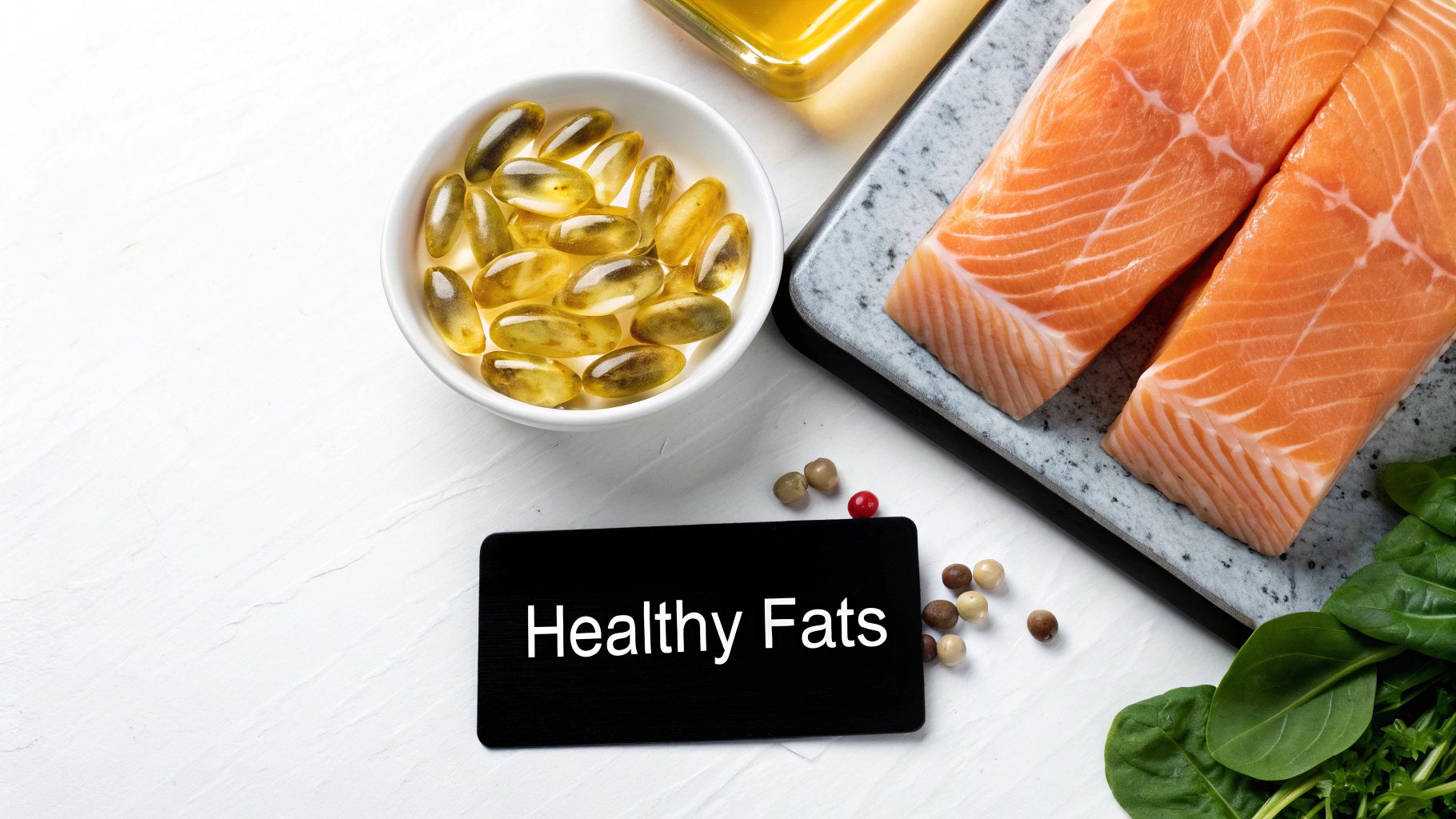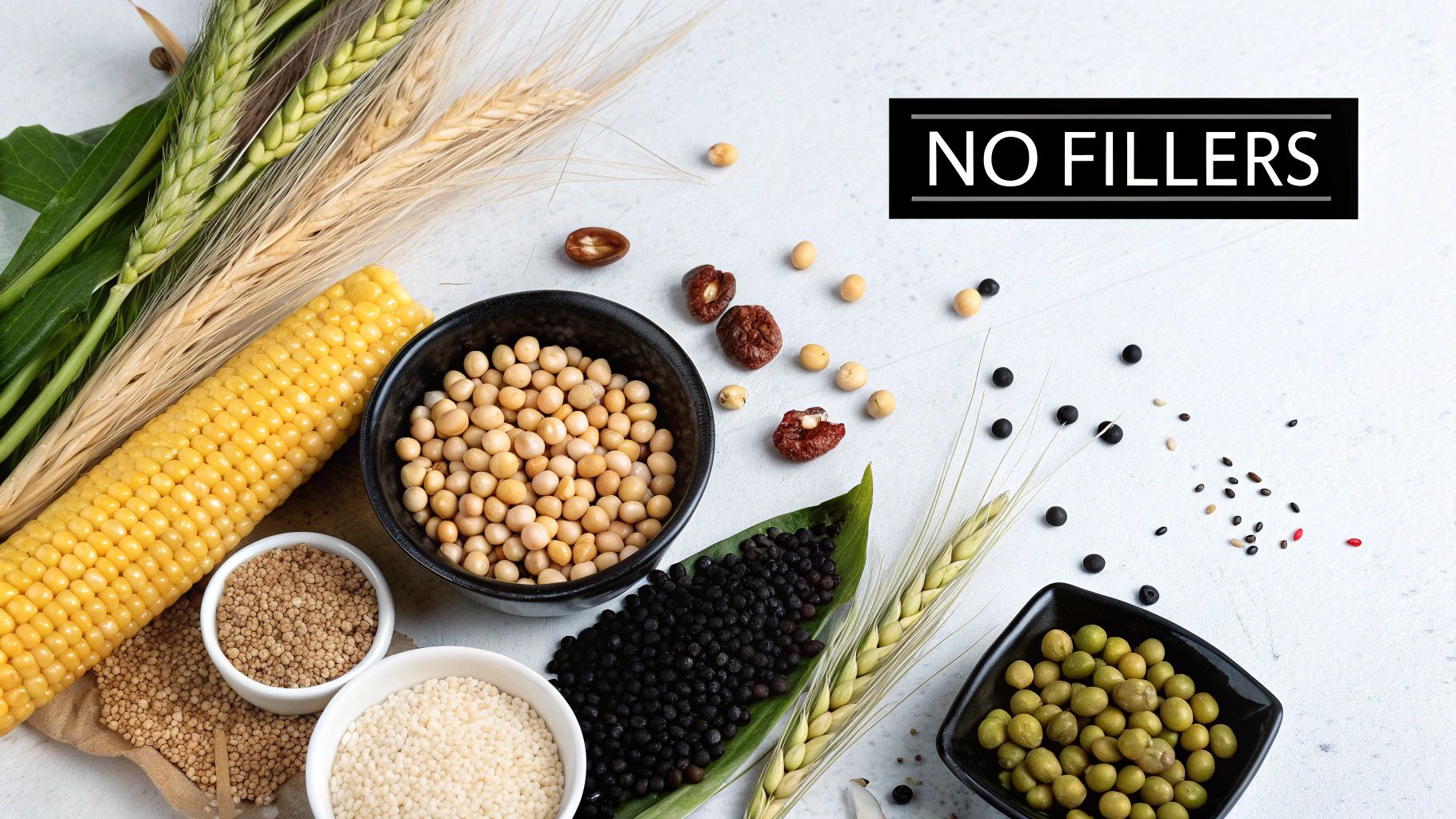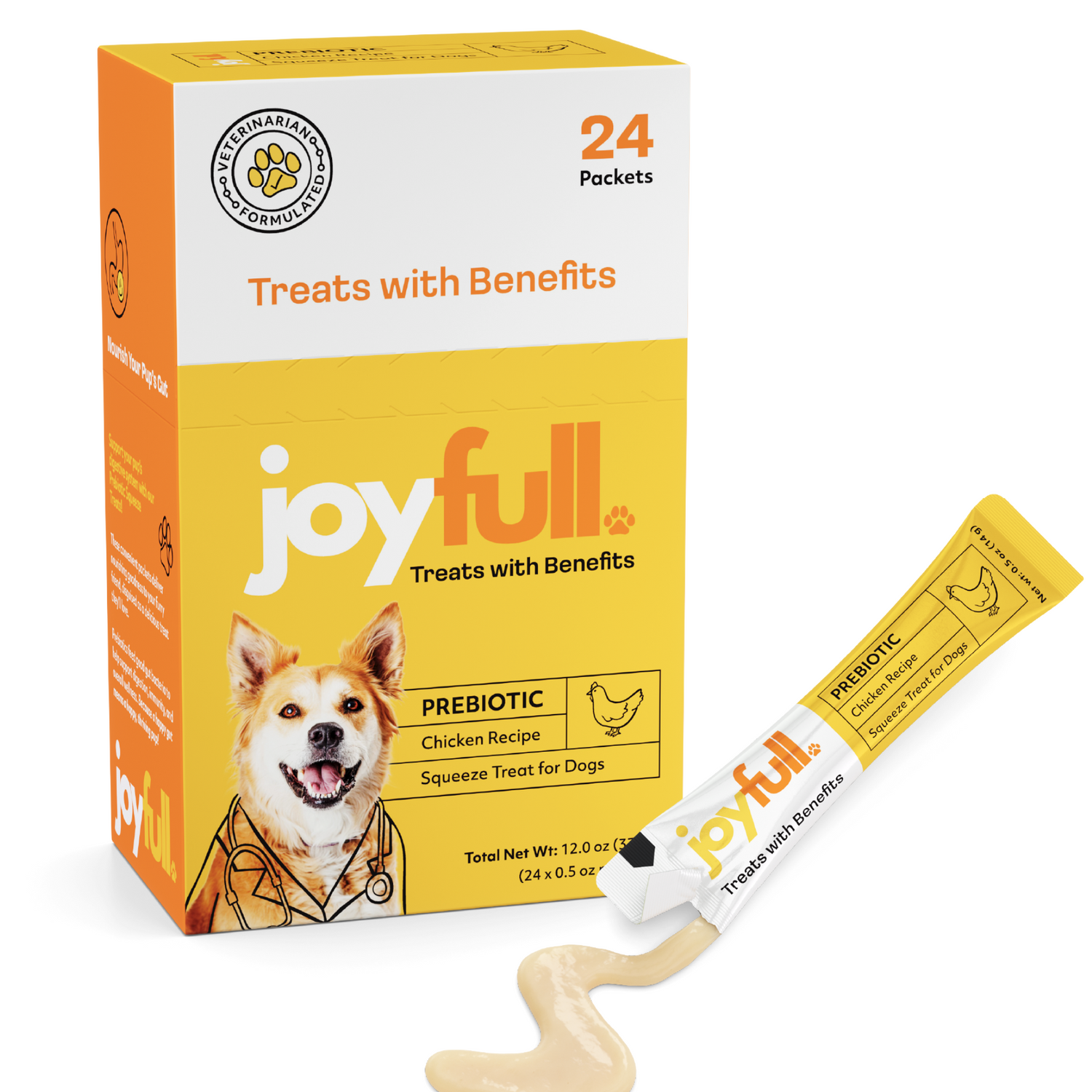
Finding the Best Cat Food Ingredients for Your Pet
When you're looking for the best cat food, the ingredient list should tell a simple story: It starts with high-quality, animal-based proteins like deboned chicken, turkey, or salmon. These superstar ingredients should be backed up by healthy animal fats and just a handful of carefully chosen carbs. The goal is to get as close as possible to what a cat would naturally eat in the wild.
Start by Thinking Like a Carnivore
Before we get into the nitty-gritty of specific ingredients, we need to lock in one core concept: your cat is an obligate carnivore.
Forget about comparing their diet to a dog's or your own. Think of your cat as a tiny, purring lion. Their entire system is hardwired to run on meat. This isn't just a preference; it's a biological necessity that dictates everything they need to be healthy.
Unlike omnivores (like us and dogs), cats just don't have the right digestive machinery to get what they need from plants. Their digestive tracts are short and acidic—perfectly designed to process animal protein and fat quickly and efficiently.
Why Animal Protein Isn't Just a Suggestion
Because of this biological setup, cats don't just do better on meat; they absolutely require it to live. Plant proteins from ingredients like corn, peas, or soy are a poor substitute. They're missing some of the essential building blocks—amino acids—that a cat's body can't make on its own.
Trying to fuel a cat with plant protein is like trying to build a solid brick wall with a few key bricks missing. The whole structure is compromised. Over time, a diet lacking the right animal-based nutrients can lead to some serious health problems.
A diet centered around high-quality animal protein is critical for:
- Strong, Lean Muscles: Keeping them ready for pouncing, climbing, and the occasional midnight zoomies.
- Healthy Organs: Powering everything from their heart to their kidneys.
- All-Day Energy: Fueling their life, whether they're bird-watching from the window or curled up on your lap.
Once you truly grasp that your cat is an obligate carnivore, reading a food label becomes much easier. It acts as your filter, helping you instantly spot the difference between foods built for your cat's biology and those packed with cheap, inappropriate fillers.
The Science in Their Food Bowl
So, what does this mean in practical terms? Cats need a diet loaded with animal-based protein and specific nutrients they can't make themselves. The most famous of these is taurine, an amino acid crucial for heart function and vision.
Research consistently shows that a healthy cat's diet should contain at least 30-45% protein (on a dry matter basis). And crucially, that protein needs to come from real meat, poultry, or fish to support their metabolism and muscle mass. If you're curious about the industry trends, you can explore more market insights about cat nutrition to see how this science shapes what ends up on the shelf.
Understanding this "why" is the first step. It empowers you to confidently pick out the best ingredients and appreciate why your cat's needs are so different. When you see "chicken" or "salmon" listed first on the bag, you know the food is starting from a place of respect for your cat’s inner carnivore.
Decoding High-Quality Protein Sources
Protein is the cornerstone of your cat’s diet, but here’s the thing: not all protein is created equal. The single most important concept to wrap your head around is bioavailability. It’s a fancy word, but it just means how easily your cat’s body can actually digest, absorb, and use the protein in their food.
Think of it this way. You’re building something with LEGOs. High-quality animal proteins—like chicken, fish, or turkey—are like perfectly formed LEGO bricks that snap together effortlessly. Plant proteins from corn or soy? They're more like misshapen, off-brand blocks. You might be able to make them fit, but the final structure will be weak and unstable. Your cat’s body works the same way.
This visual breakdown shows some of the best protein "bricks" you can find for your cat.
When you stick to these kinds of named, whole-food proteins, you're giving your cat the absolute best building materials for a healthy life.
Spotting Quality on the Ingredient List
So, how do you find the good stuff? It starts with a quick scan of the ingredient list. The best brands are proud of what’s in their food and they make it easy to see.
You're looking for clear, specific names that you can easily picture.
- The Gold Standard: Look for things like "deboned chicken," "turkey," "salmon," or "beef." These are whole meats, and they should ideally be at the top of the list.
- A Solid Second: Named meat "meals" like "chicken meal" or "salmon meal" are also excellent. Don't let the word "meal" scare you; it's just the meat with the water and some fat removed, which makes it a super-concentrated source of protein.
- The Red Flags: Be wary of vague, generic terms. Phrases like "meat by-products" or "poultry by-products" are a huge question mark. This can be a mix of less digestible parts like feet or intestines, and the lack of specificity is a bad sign.
Your goal is to avoid mystery meat. If the company isn't telling you exactly which animal the protein came from, you should wonder why. To dive deeper into this, our guide on cat food with high protein breaks it all down.
To make it even simpler, here's a quick cheat sheet for what to look for when you're standing in the pet food aisle.
High-Quality vs. Low-Quality Protein Sources
| Ingredient Type | What to Look For (The Good Stuff) | What to Question (The Ambiguous Stuff) |
|---|---|---|
| Whole Meats | "Chicken," "Deboned Turkey," "Salmon" | "Meat," "Animal" (without specifying the source) |
| Meat Meals | "Chicken Meal," "Lamb Meal," "Fish Meal" | "Meat and Bone Meal," "Animal Meal" (again, no source) |
| By-Products | (Generally avoid, but if present) "Chicken By-Product Meal" is better... | ...than the truly vague "Meat By-Products" or "Poultry By-Products" |
| Plant Proteins | Used sparingly as binders (e.g., peas, lentils) is okay. | Corn gluten meal, soy protein, wheat gluten as primary proteins. |
This table isn't about perfection, but about making informed choices. The more ingredients you see in "The Good Stuff" column, especially at the top of the list, the better the food likely is.
The Building Blocks: Amino Acids
Why all this fuss about animal protein? It boils down to amino acids—the microscopic building blocks that construct everything in your cat's body, from their muscles and organs to their fur and claws.
Animal-based proteins are "complete," meaning they deliver every single essential amino acid your cat needs. Cats are obligate carnivores, which means they are biologically designed to get their nutrition from meat.
Two amino acids are absolutely non-negotiable for cats: taurine and arginine. Unlike dogs or people, cats can't make enough of these on their own. They must get them from their food, and animal tissue is the only reliable source.
A lack of taurine is a serious problem. It can lead to a devastating heart condition called dilated cardiomyopathy (DCM) and even cause irreversible blindness from retinal degeneration. This isn't just a "nice-to-have" nutrient; it's a matter of life and death.
This is exactly why you'll never see a veterinarian recommend a vegan or vegetarian diet for a cat. Plant-based proteins simply don't contain these crucial nutrients in the right amounts, and it's a dangerous gamble to take with your cat's health.
The Impact of Real Meat Content
This focus on real, named meat isn't just a marketing gimmick; it's a trend driven by solid science and better health outcomes.
For example, a major 2015 study found a direct link between cat foods containing at least 40% real meat content and better overall health, including lower rates of obesity and chronic kidney issues. More recently, a 2023 industry report showed that around 70% of new cat food formulas are introducing novel proteins like duck, rabbit, or venison. They're doing this not only to tempt picky eaters but also to provide a wider range of essential amino acids.
The pet food industry is finally catching up to what we've known for years: high-quality animal protein is the key to a cat's vitality. By learning to read the label and prioritize these ingredients, you're making a direct investment in your cat’s long-term health and happiness.
Let's talk about fat. For decades, we've been told fat is the enemy, but in your cat's world, it's anything but. High-quality fat is a super-concentrated energy source and one of the most important components of their diet.
Gram for gram, fat packs more than twice the energy of protein or carbs. This makes it an incredibly efficient fuel for everything from chasing a laser pointer to a long afternoon nap in a sunbeam.
But it’s more than just fuel. Think of healthy fats as the delivery service for crucial fat-soluble vitamins—specifically vitamins A, D, E, and K. Without fat to carry them, these essential nutrients can't be absorbed and put to work, no matter how much are packed into the food.

Just like with protein, the source of the fat is what really counts. The best, healthiest cat foods will always feature high-quality, clearly named animal fats.
What to Look For on the Label
When you're scanning the ingredients list, you're looking for transparency. Vague, generic terms are a major red flag, while specific sources signal a manufacturer that cares about quality.
- Excellent Sources: Keep an eye out for ingredients like chicken fat, salmon oil, or fish oil (often from sources like sardines or anchovies). These are exactly what a carnivore's body is designed to use.
- Proceed with Caution: Be wary of generic terms like "animal fat." It's not necessarily harmful, but it's not transparent, either. If a company was using a great source like duck fat, they'd almost certainly want to brag about it on the label.
Think of healthy animal fats as the essential lubrication for your cat's internal machinery. They keep everything running smoothly, from their joints to their brain function, ensuring peak performance and longevity.
This vital lubrication comes from specific types of fats called fatty acids, which fall into two major families: Omega-6 and Omega-3. Getting the balance right is key.
Getting the Omega Balance Just Right
For your cat to truly thrive, they need a healthy ratio of both Omega-6 and Omega-3 fatty acids. They each have distinct but equally important jobs to do.
Omega-6 fatty acids are typically found in animal fats like chicken fat. The all-star here is arachidonic acid. This is a non-negotiable for cats. Unlike dogs or people, cats can't synthesize it themselves; they must get it directly from their food. It’s absolutely vital for their reproductive systems, skin health, and maintaining a normal inflammatory response.
Omega-3 fatty acids, on the other hand, are the anti-inflammatory superstars. Usually sourced from fish oils like salmon or sardine oil, these are the fats that often create the most visible improvements in your cat's health.
The benefits of a diet rich in Omega-3s are easy to see:
- A Healthy, Shiny Coat: They nourish the skin and fur from the inside out, leading to less shedding and a beautiful, soft coat.
- Supple, Healthy Joints: Their natural anti-inflammatory properties help soothe joints and maintain mobility, which is especially important for senior cats.
- Sharp Cognitive Function: These brain-boosting fats are crucial for kitten development and help keep older cats mentally sharp.
So, when you're evaluating a cat food, don't just stop at the protein. Dig a little deeper and look for those named, high-quality animal fats. Seeing ingredients like chicken fat and fish oil is a fantastic sign that the food is designed not just to fill a bowl, but to truly nourish your cat for a long, vibrant life.
Sorting Through Carbs and Fillers: What Your Cat Really Needs
Carbohydrates are probably the single most controversial and misunderstood ingredient in cat food. Let's get straight to the point: cats are obligate carnivores. This means they have absolutely no biological need for carbohydrates. Their bodies are finely tuned machines designed to thrive on animal protein and fat, not a diet loaded with starches.
Of course, they can digest and use a small amount of carbs for a quick energy burst. But a high-carb diet is fundamentally mismatched with their evolutionary design. Think of it like putting regular, low-octane gas in a high-performance sports car. It might sputter along for a bit, but you're setting the stage for serious, long-term engine damage. The same logic applies to your cat.
When a cat's diet is packed with unnecessary carbohydrates, it can lead to a whole host of problems. We're talking about issues like obesity, unstable blood sugar, and even a higher risk of developing feline diabetes. This is precisely why learning to spot high-carb foods is one of the most important skills you can develop as a cat owner.
Good Carbs vs. Junk Fillers
Now, this doesn't mean every single carbohydrate is a villain. In very small, controlled amounts, some carbs can actually serve a useful purpose. The trick is learning to tell the difference between a functional, low-glycemic ingredient and a cheap, high-glycemic filler that's only there to cut costs for the manufacturer.
A tiny bit of the right kind of carb can be helpful:
- Pumpkin or Sweet Potato: These can provide a great source of soluble fiber, which is fantastic for healthy digestion and can help your cat pass hairballs more easily.
- Cranberries or Blueberries: You might see these added for their antioxidant benefits, and they're also known to support good urinary tract health.
The real problem starts when you see cheap fillers crowding the top of the ingredient list. These are the empty calories of the pet food world.
If you glance at an ingredient panel and see corn, wheat, or soy listed before the third or fourth animal protein, that's a massive red flag. It’s a dead giveaway that the food is built on a foundation of cheap plant matter, not the quality meat your little carnivore is built to eat.
These high-glycemic fillers cause a sharp, sudden spike in blood sugar that a cat's metabolism just isn't designed to handle. Day after day, this puts a huge strain on their system and can lead to serious metabolic stress down the road.
The "Grain-Free" Myth
The grain-free trend took the pet world by storm, and while it started with good intentions, it's often incredibly misleading. Pet owners correctly figured out that grains like corn and wheat weren't great for their cats. The problem? Manufacturers simply swapped them out for other starchy ingredients that are just as bad, if not worse.
Trading corn for a huge helping of potatoes, tapioca, or peas doesn't fix the underlying issue. A bag of kibble labeled "grain-free" can still be packed with up to 40% carbohydrates—a staggering amount for a carnivore. The marketing on the bag might look good, but to your cat's body, it's just another heavy load of starch to process.
The goal was never just to be grain-free; it's to be low-carbohydrate. A genuinely high-quality cat food will always put animal protein and fat first, keeping the total carb count to an absolute minimum.
How to Become a Carb Detective
Since pet food companies aren't required to list the carbohydrate percentage on the "Guaranteed Analysis" label, you have to do a little detective work yourself. Your best tool is the ingredient list.
Here’s a quick mental checklist to use when you're shopping:
- Count the Meats: Look at the first five ingredients. You want to see at least three or four of them be named animal sources, like "deboned chicken" or "salmon meal."
- Hunt for Fillers: Actively scan for those cheap, high-carb fillers: corn, wheat, soy, white potatoes, and tapioca. The lower they are on the list—or better yet, not on the list at all—the better the food.
- Judge the Purpose: If you see pumpkin or cranberries listed way down, you can recognize their potential role in digestion or urinary health. But if you see "corn gluten meal" near the top, you know it's just being used as a cheap, inferior protein substitute.
By adopting a meat-first, low-starch mindset, you can see right through marketing gimmicks like "grain-free" and focus on what really counts: feeding your cat a diet that honors their biology. This is one of the most powerful choices you can make for their lifelong health.
Vitamins, Minerals, and Essential Supplements
Protein and fat might be the main event in your cat's bowl, but the real magic happens with the micronutrients. Think of it like a master chef's signature dish. The high-quality meat is the star, of course, but it’s the pinch of this and dash of that—the specific vitamins, minerals, and other key supplements—that truly perfect the meal. These are the ingredients that make the best cat foods truly complete.
Even the most premium, meat-first cat foods need to be fortified. Why? Because the cooking and processing involved in making kibble or canned food can degrade some of the natural nutrients. To earn that "complete and balanced" seal of approval from AAFCO, manufacturers must add back specific vitamins and minerals to ensure your cat isn't missing out on anything crucial for their long-term health.

The Unsung Heroes of Feline Health
Vitamins and minerals make up a tiny percentage of the food by weight, but they do some seriously heavy lifting. They are the spark plugs firing up your cat’s internal engine, enabling thousands of tiny biological processes that control everything from their sharp vision to their playful bursts of energy.
Here are a few key vitamins you'll want to spot on a quality cat food label:
- Vitamin A: Absolutely essential for good vision, a strong immune system, and healthy skin. Here's a fun fact: cats can't make Vitamin A from plants like carrots (beta-carotene) the way people can. They must get it ready-made from animal sources.
- B Vitamins (B1, B6, B12, etc.): This family of vitamins is the powerhouse for energy metabolism, a healthy nervous system, and producing red blood cells. Since they are water-soluble, they get flushed out of the body and need to be replenished daily.
- Vitamin D: You know it as the "sunshine vitamin," but cats can't synthesize it from sunlight. It's a mandatory dietary ingredient that helps them balance minerals like calcium and phosphorus for strong, healthy bones.
Then you have the minerals, which provide the structural scaffolding and help regulate the body. Calcium and phosphorus are the famous duo for building strong bones and teeth, but getting their ratio right is critical. You'll also see things like zinc added to support supple skin and a robust immune response.
A well-made cat food doesn't just throw in a generic vitamin mix. It features a carefully calibrated blend of these micronutrients, designed specifically to meet the unique needs of an obligate carnivore. Nothing is left to chance.
Functional Supplements for an Extra Edge
Beyond the non-negotiable vitamins and minerals, the very best cat food ingredients often include "functional" supplements that offer targeted health perks. These are the thoughtful extras that elevate a good food to a great one, often addressing common cat health issues head-on.
Two of the most valuable additions you should look for are:
- Probiotics and Prebiotics: Think of these as your cat's gut health team. Probiotics are the "good" bacteria, and prebiotics are the specific types of fiber that feed them. Together, they create a thriving gut environment, which is the cornerstone of a strong immune system and smooth digestion.
- Antioxidants: Ingredients like blueberries, cranberries, or supplemental Vitamin E act like cellular bodyguards. They help neutralize unstable molecules called free radicals, protecting the body from damage and supporting overall immunity. As a bonus, cranberries are also well-known for helping to maintain a healthy urinary tract.
To dive deeper into how these and other additions can support your cat, you can learn more about the best supplements for cats in our detailed guide. These aren't just trendy buzzwords on a bag; they are purposeful ingredients that fine-tune your cat's diet, helping them thrive from the inside out.
How to Read a Cat Food Label Like an Expert
Alright, you now know what makes up a healthy meal for your cat. Let’s put that knowledge to work in the real world: the pet food aisle. A cat food label can look like a jumble of fine print and confusing percentages, but it’s actually a roadmap to your cat's well-being. Once you know what to look for, you can cut right through the flashy marketing and see what’s really inside the bag.
Think of the label as having three main parts. Each one tells a piece of the story. Get a handle on these, and you'll go from a guessing game to making confident, informed choices for your feline friend.
Start with the Ingredient List
The first place my eyes always go is the ingredient list. This is, without a doubt, the most revealing part of the entire package. In the United States, ingredients have to be listed by their pre-cooked weight, from most to least. This simple rule gives you an incredible amount of insight into what the food is really made of.
Focus on the first five ingredients. These make up the vast majority of the recipe. What you want to see is a lineup that reads like a carnivore’s dream menu:
- Deboned Chicken: A fantastic start. It's a whole, identifiable animal protein.
- Chicken Meal: Don't let the word "meal" fool you; this is a highly concentrated protein source. Another great sign.
- Turkey: More high-quality, named animal protein. Perfect.
- Chicken Fat: A specific, named animal fat is exactly what you want for energy.
- Salmon Oil: An excellent source of those critical Omega-3 fatty acids.
This list paints a very clear picture: the food is built around meat, just as a cat's diet should be. It’s a huge green flag. On the flip side, if you see corn, wheat, or vague terms like "meat by-products" at the top of the list, you know you’re looking at a product built on cheap, less nutritious fillers. Knowing the difference is everything, and you can learn even more in our guide to the top cat food ingredients to avoid.
Decode the Guaranteed Analysis
Next, find the box labeled "Guaranteed Analysis." This section gives you the minimum percentages of crude protein and fat, along with the maximums for crude fiber and moisture.
It seems straightforward, but there’s a small catch. These numbers are presented on an "as-fed" basis, which means the water content is included. This makes it tricky to directly compare a wet food to a dry kibble. However, for a quick check, you can still get a good feel for the food's nutritional priorities. For dry food, I look for protein levels of 30% or higher, moderate fat, and low fiber.
The Guaranteed Analysis tells you what nutrients are in the food. The ingredient list tells you the far more important how—revealing the quality of the sources providing those nutrients. You need both for the full story.
Pet owners are catching on. Recent market data shows that nearly 35-40% of pet food buyers across the globe now consider ingredient transparency a top priority. This shift proves that savvy owners aren't just looking at the numbers anymore; they want to know the quality and origin behind them. You can explore more about this trend in global pet food market reports.
Decoding the Guaranteed Analysis Panel
The Guaranteed Analysis is a standardized panel required on every pet food label. At first glance, the percentages can be a bit misleading because they include moisture. To truly compare different foods (especially wet vs. dry), you need to calculate their "dry matter basis." But even on its own, the panel gives you a snapshot of the food's nutritional profile. Here’s a quick guide to what those numbers actually mean.
| Nutrient | What It Means | Ideal Range (Dry Matter Basis) |
|---|---|---|
| Crude Protein (Min) | The minimum amount of protein in the food. This is vital for muscle, tissue repair, and overall health. For cats, the source of the protein (animal vs. plant) is just as important as the percentage. | 35% - 50% |
| Crude Fat (Min) | The minimum amount of fat, which is your cat’s primary energy source. It’s also essential for absorbing vitamins and maintaining healthy skin and coat. Look for named animal fats. | 15% - 25% |
| Crude Fiber (Max) | The maximum amount of indigestible fiber. A small amount aids digestion, but too much can indicate the presence of low-quality fillers. | Below 5% |
| Moisture (Max) | The maximum percentage of water in the food. This is the key reason you can't directly compare wet and dry food percentages. Dry kibble is typically 10-12%, while wet food can be 75% or more. | N/A (Varies by food type) |
Ultimately, a high protein and moderate fat content sourced from quality animal ingredients is what you’re looking for. The panel confirms the numbers, but the ingredient list confirms the quality.
Find the AAFCO Statement
Finally, scan the label for the AAFCO nutritional adequacy statement. It’s usually a small bit of text, but it’s one of the most important things on the entire package. This little sentence is your official confirmation that the food is formulated to meet widely accepted nutritional standards.
You're looking for one of two key phrases:
- "[Product Name] is formulated to meet the nutritional levels established by the AAFCO Cat Food Nutrient Profiles for [life stage]." This is good. It means the recipe was carefully designed on paper to be complete and balanced.
- "Animal feeding tests using AAFCO procedures substantiate that [Product Name] provides complete and balanced nutrition for [life stage]." This is the gold standard. It means the food has been proven to work in the real world through actual feeding trials with cats.
The statement will also tell you which life stage the food is for, like "adult maintenance" or "growth and reproduction" (for kittens). Make sure it matches your cat's needs. If you can’t find this AAFCO statement, the product should only be used as a treat or a temporary supplement, not as your cat's main source of nutrition.
Your Top Questions About Cat Food Ingredients, Answered
Stepping into the cat food aisle can feel overwhelming. With so many options, it's natural to have questions. Let's clear up some of the most common ones so you can feel good about what's in your cat's bowl.
Is Wet Food Really Better Than Dry Food?
When you look purely at the ingredients, a good-quality wet food often comes out on top. It usually packs in more animal protein, has fewer carbs, and most importantly, offers a ton of moisture. This is a massive win for cats, as they don't have a strong natural instinct to drink water.
That said, a top-tier dry food can still be a fantastic option. Many pet parents find success by supplementing it with a bit of water or using wet food as a special topper. The best rule of thumb? Pick the highest-quality food in your budget, wet or dry, and make sure the label lists the best cat food ingredients like specified animal proteins and fats.
What Does "Animal By-Product" Actually Mean?
"By-product" sounds a bit mysterious, doesn't it? It simply refers to the parts of an animal that are left over after the meat we typically eat is processed. Sometimes, this includes incredibly nutritious organ meats like liver and kidneys. Other times, it can mean less digestible parts like feet or intestines.
The real problem here is the lack of clarity. An ingredient like "chicken by-products" is slightly better than the super-vague "meat by-products" because you at least know the animal it came from. In general, though, it's often a marker of a lower-quality food compared to one that proudly lists whole meats or clearly named meat meals.
How Do I Switch My Cat to a New Food Without Causing Tummy Trouble?
This is a big one! Switching food cold turkey is a recipe for an upset stomach. The secret is to go slow, giving your cat's digestive system 7-10 days to get used to the new recipe.
Start by mixing just a little of the new food (about 25%) into their current food (75%). Every couple of days, slowly increase the amount of new food and decrease the old. Keep this up until you're feeding 100% of the new formula. This gradual approach is the kindest way to make a change.
Providing your cat with excellent nutrition is fundamental to a long and happy life. That incredible bond we share also means thinking about every part of their well-being, from their daily meals to eventually honoring your pet's memory in a meaningful way.
At Joyfull, we're all about making pet wellness simple and effective. We craft our formulas with clean ingredients and premium proteins, and every recipe is scientifically reviewed by our veterinary advisor. We do this to ensure your cat receives the outstanding nutrition they deserve. See our commitment to better pet health for yourself at https://joyfullpet.com.

